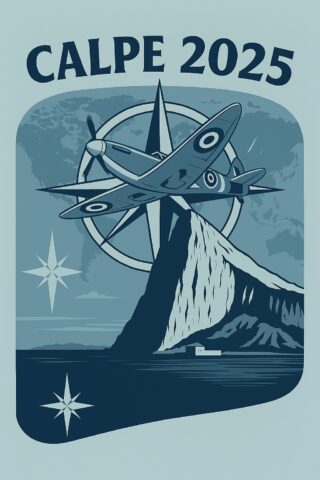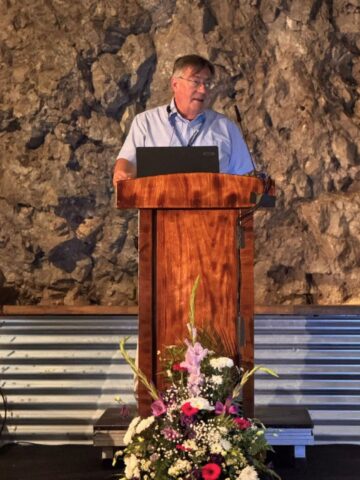The Calpe Conference 2025: A personal view Part One
This is the first in a three-part series on this year’s Calpe Conference. Part two will be published tomorrow.
By Dr Alex Menez
This year’s Calpe Conference was the 29th and ran from September 18-20.
Titled ‘Gibraltar in the Second World War and in other global conflicts: the importance of geography,’ the location, the World War II Tunnels at Hays Level, synergized the conference’s themes perfectly, especially as 2025 is the 80th anniversary of the end of World War II.
Recently restored and reopened to the public in August 2023, it “forms part of a vast tunnel system initially built by the Royal Engineers during WWII to provide stores, accommodation, hospitals, and underground electrical generators providing support for British troops.”
The brochure of the site cleverly notes that it is “An Underground City of Wartime Strategy.”


Certainly, the huge hall in which the conference was held, surrounded by solid limestone, a replica Spitfire suspended from above, must have made a good number of people think that this was not just any location.
Professor John Cortes, Minister for Education, Public Health, Environment, Sustainability, Climate Change, Heritage, and Culture, welcomed all and said: “It is with great pleasure that I, once more, inaugurate a Calpe Conference, the 29th in the series and my 10th as Minister for Heritage.”
He mentioned speakers that would be presenting at the conference, and added emotionally that “sadly, Professor Larry Sawchuk passed away earlier this year.”
“My friend Larry was a friend to many of us in Gibraltar. His scholarship was matched by a friendly character that made us all love him.”
The minister shared his “excitement at the work we are doing in Gibraltar to protect, enhance and promote the value of our heritage,” including the renovation and restoration at Moorish Castle, the Northern Defences, and other sites.
I chaired the entire conference this year. Professors Geraldine and Clive Finlayson, and Dr Stewart Finlayson, the three from the Gibraltar National Museum, University of Gibraltar, and Liverpool John Moores University, were the first speakers.
Geraldine noted that “a topographically dramatic location such as Gibraltar, which was visited or has been occupied by people, starting with the Neanderthals, can be seen as one of those special places in the world sometimes referred to as a geographical icon.”
She explained that “the Rock was thrust into place as a consequence of the African-European collision that promoted a westwards displacement of the internal zones of the Betic Range, mainly during the Early Miocene, with the generation of the so-called Gibraltar Arc,” describing “our knowledge of the significance that it had in three different time periods.”
The first was “the relatively unknown period between the 9th century and the 2nd century BCE, a time of significant conflict in the Mediterranean between Greeks, Phoenicians and Carthaginians,” the second period being the “Islamic invasion of the Iberian Peninsula, and the concept of al-Andalus,” noting that “it all started here in Gibraltar in 711CE.”
The third was the “iconic image of the fortress as a symbol of strength developed over the 250-year period which spanned a series of global conflicts,” which included the “War of the Spanish Succession (1701−1714), the American War of Independence (1755−1783), the Napoleonic Wars (1792−1815), the First World War (1914−1918) and the Second World War (1939−1945), of course extending later as the Cold War and beyond.”
After coffee, Dr Francisco Jiménez Espejo from the Consejo Superior de Investigaciones Científicas spoke about “the first landing in Gibraltar.”
He explained that the Carthaginians in the 3rd century and the Moors around 170 CE, “were the first recorded incursions or invasions by African troops into the south of the Iberian Peninsula.”
The Muslim invasion of 711 CE was the first that had its base of operations in the Gibraltar/Algeciras area.
Franscisco described how the arrival “was preceded by particular environmental conditions, characterized by aridity and cold.”
Pollen records from Iberia and Morocco, palaeohydrological records, archaeological data, and historical sources, were used to provide a reconstruction of the environmental conditions that “may have influenced the expansion of the Umayyad Caliphate,” also possibly explaining the “socio-political problems that affected the last Visigothic reign.”
The next presentation by Professor Clive Finlayson, Dr Stewart Finlayson, and Geraldine Finlayson, the three from the Gibraltar National Museum, University of Gibraltar, and Liverpool John Moores University, was a remarkable account of the history of “the Gibraltar Crusade and the Battle for the Strait of Gibraltar.”
Battles, conflicts, territories gained and lost, “alliances and counter alliances, even between Muslims and Christians” and more, bring to life the detailed history of centuries.
The narrative began and ended with Gibraltar’s Tower of Homage.
I contemplated that the genesis of the presentation was the current restoration and research of the Moorish Castle, supervised and managed by the Gibraltar National Museum.
Clive noted that the tower “is massive… measuring 20x17 metres at its base,” this making the “Gibraltar tower the largest that was ever built in the territory of al-Andalus.”
Clive’s key question was “why was such a massive tower built on Gibraltar?”
In closing he said: “Was Abu ‘l-Hasan’s intention, in building this huge keep, solely military?”
“Having taken Gibraltar from the Castilians, who had in turn taken it from the Nasrids, was he also making a bold statement of power and achievement, both to the Castilians and to his fellow Nasrids? He did so by raising the biggest tower ever built in al-Andalus.”
Following lunch, Colonel (Ret.) Jason R. Musteen, armour/cavalry officer and associate professor at the United States Military Academy at West Point, described that thousands of people “fell to variously diagnosed epidemic diseases that ravaged the Mediterranean coast during the global conflict brought about by the French Revolution.”
The population and garrison of Gibraltar were affected and “dreadful outbreaks on the Barbary Coast and in some of the larger Spanish cities forced the military governors of Gibraltar to restrict or quarantine vessels arriving from affected ports.”
In Gibraltar, battle waged on “against an elusive enigmatic enemy” where a few British Army surgeons diagnosed and attempted to control “the mysterious fevers.”
As a result, Jason noted that “through their subsequent writings, Gibraltar’s physicians initiated the global effort to defeat the violent killer then known as Gibraltar Fever.”
Next was Professor Jason Dittmer from University College, London. He noted that “Gibraltar has long been understood as a strategic location.”
He explained the rise of “relational geography and assemblage thinking to re-theorise the idea of strategic locations,” including Gibraltar.
He held that “the ‘unchanging truth’ of geography as asserted by (neo)classical geopolitical authors is always in fact becoming otherwise, as shifts in the compositional assemblages,”
including military-technological systems and domestic politics, “can ripple through the place in question, very quickly making strategic places un-strategic again, or vice-versa.”
He noted that the “materiality of the Strait of Gibraltar” and the Rock “both interact with various shifts in military technology and the organization of empires.”
Earlier, I mentioned the wonderful location where the conference was held, the World War II Tunnels at Hays Level.
The final talk of the day was by Christian Wright, Managing Director of Wright Tech Ltd who leads the ongoing restoration and upgrade of the World War II Tunnels.
I found the presentation interesting, with descriptions, images, and video of the works that were undertaken for the restoration, showing “the transformation of Gibraltar’s World War II Tunnels into a dynamic, immersive heritage attraction.”
The vision outlined by Christian is “to preserve the tunnels’ authenticity while creating compelling visitor experiences through storytelling and thoughtful interpretation.”









